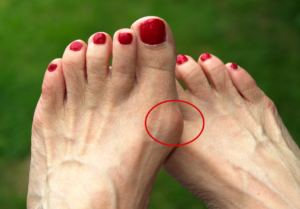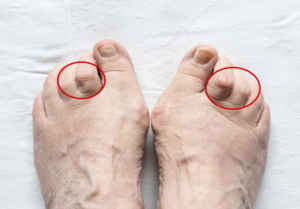


Bunions and hammertoes are types of deformities that occur in the feet and can lead to discomfort and many other problems. Both are progressive conditions that can worsen over time without proper treatment. While these conditions share many similarities, they also have a few differences, and it’s important to understand both when dealing with bunions or hammertoes. Read on to learn about these conditions and the treatment options available, including when surgery may be needed.

A bunion is a foot deformity that happens when the big toe shifts toward the smaller toes, causing the joint at the base of the toe to stick out. It’s generally described as a bony bump at the base of the big toe. Excess pressure on the big toe pushes it out of alignment, causing it to point inward. The same thing can happen to your pinky toe. This is called a tailor’s bunion or a bunionette. Both bunions and bunionettes are caused by excess pressure. Other types of bunions include:

Hammertoe is a foot deformity that causes your toes to bend at the second joint, often getting stuck in a curled position. Hammertoe usually occurs in your smaller toes, most often the second, third and fourth toes. This condition causes the affected toes to be bent all the time, making it difficult and even impossible to flatten. Similar to bunions, hammertoes are caused by excess pressure that pushes the toe out of alignment. There are two main types of hammertoes:
Although these two conditions affect the foot differently, they have similar causes. Both can be caused by genetic factors or abnormal bone conditions. Various health conditions that cause inflammation or affect the feet, like diabetes or rheumatoid arthritis, increase an individual’s risk of developing these deformities.
Bunions and hammertoes are most often caused by excess pressure on the feet, usually from wearing tight or ill-fitting shoes. If you have high arches, flat feet or longer toes, you’re more likely to develop hammertoes, since you may struggle to find shoes that fit properly. It’s common for people who stand for long periods or work on their feet to develop bunions, due to increased pressure on the foot. Bunions can even be a cause of hammertoes, but hammertoes can’t be a cause of bunions.
Like the causes of bunions and hammertoes, the symptoms are similar. They can both make it painful to walk or affect your ability to balance. The main difference is that with bunions, you may experience numbness or develop hammertoes. Here are the common symptoms of bunions and hammertoes:
For both bunions and hammertoes, the main form of prevention is wearing comfortable, properly-fitting footwear. Avoid wearing shoes that are too tight or narrow, as this puts pressure on the toes and causes them to shift out of alignment. When you’re shopping for shoes, try on various sizes and do a test walk to ensure the proper fit. Maintain a healthy weight to prevent excess stress on the feet, and always practice healthy habits that keep your feet in good shape, like stretching exercises to increase strength and massages to release tension.
Conservative treatments are often used to relieve some of the symptoms of bunions and hammertoes. These include:
In more severe stages of bunions and hammertoes, when conservative treatments fail to provide relief, surgery may be recommended. There are several types of bunion surgeries, and the one that’s right for you will depend on the stage of the condition and the symptoms you’re experiencing. The same is true for hammertoes. If you’re dealing with either condition and conservative treatments are no longer helping, reach out to a podiatrist to learn about your treatment options.
The Irving podiatrists at North Texas Foot and Ankle specialize in all foot and ankle conditions, including bunions and hammertoes. Based on your symptoms, we will develop a treatment plan tailored to you. We will determine whether you need nonsurgical or surgical treatment, and we will support you every step of the way. If either of these conditions is impacting your daily life or bringing you discomfort, reach out to our team by calling us at (214) 574-9255 or contacting us online.
Call to schedule your appointment with any of our doctors.
| Cookie | Duration | Description |
|---|---|---|
| cookielawinfo-checbox-analytics | 11 months | This cookie is set by GDPR Cookie Consent plugin. The cookie is used to store the user consent for the cookies in the category "Analytics". |
| cookielawinfo-checbox-functional | 11 months | The cookie is set by GDPR cookie consent to record the user consent for the cookies in the category "Functional". |
| cookielawinfo-checbox-others | 11 months | This cookie is set by GDPR Cookie Consent plugin. The cookie is used to store the user consent for the cookies in the category "Other. |
| cookielawinfo-checkbox-necessary | 11 months | This cookie is set by GDPR Cookie Consent plugin. The cookies is used to store the user consent for the cookies in the category "Necessary". |
| cookielawinfo-checkbox-performance | 11 months | This cookie is set by GDPR Cookie Consent plugin. The cookie is used to store the user consent for the cookies in the category "Performance". |
| viewed_cookie_policy | 11 months | The cookie is set by the GDPR Cookie Consent plugin and is used to store whether or not user has consented to the use of cookies. It does not store any personal data. |
